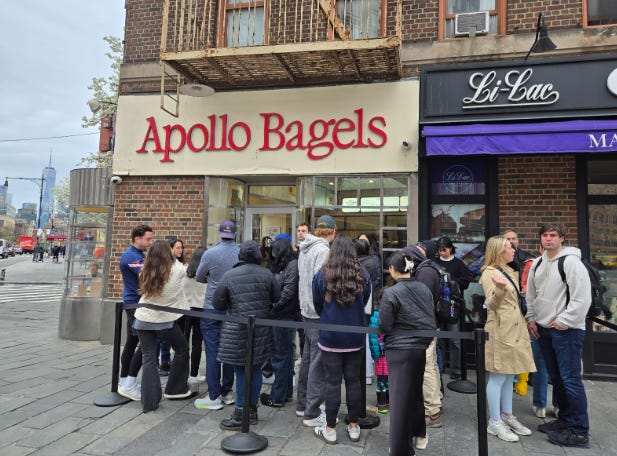Are there strategy lessons to be learned from bagel purveyors?
100%.
Let me start by saying that in NYC, bagels are not a commodity. Sure, you can get an undistinguished lump of dough at corner delis and coffee carts. But if you ask the average New Yorker, most will have an opinion about the “best” bagel, at least in their neighborhood.
New Yorkers are proud of their bagels, which are distinctive for their large size and the water they are boiled in before they are baked. (New Yorkers are proud of their water, too.)
Loyalty to a favorite bagel producer has been happening for a century, and it means that the bagel landscape didn’t change much over the years. Legacy bagel producers kept to a standard menu with, at minimum:
Plain
Everything
Sesame
Poppyseed
Cinnamon raisin
Whole wheat
Overachievers added salt, onion, and sometimes some weird flavors etc. to the menu mix. Some bagel shops, like Zucker’s, have more than 20 varieties.
Indeed, the biggest innovation in the late twentieth century was breadth. Certain bagel shops now offer nearly as many flavors of cream cheese as bagels and a plethora of smoked fish, not to mention every type of sandwich filling.
As a result, unless you know your bagel business, you can spend a full ten minutes standing at the bagel counter trying to decide what order to place.
There’s nothing like walking by a bagel bakery early in the morning and smelling fresh bagels. But you can see how all that NYC pride and tradition could make the legacy bagel landscape a little complacent, maybe even lazy.
Luxe with Lox
If you’ve ever been to New York City, you probably know that you can find a luxury version of just about anything. So it was just a matter of time before luxury came for the bagel. And just to be clear: a $36 bagel with lox at a fancy midtown hotel is not a luxury bagel. That’s just an expensive bagel.
Black Seed was the first to take a run at upscaling the bagel. In 2014, they introduced a line of bagels with artisan flours and a touch of honey (rather than the standard NYC-style barley malt) in the water. The bagels were petite compared to their NYC brethren, and there was mention of Montreal as an inspiration.
Black Seed bagels are chewy-delicious but, frankly, I find them a bit overdone, and I don’t mean overbaked. “[F]ired… by hand in a wood-burning oven,” touts the company’s website. Post-firing, a “hard-carved wooden peel” sends the bagels on their journey down a “marble chute” where they may eventually encounter “house-made almond butter.” A bit precious, don’t you think?
But Black Seed prospered, although they didn’t stray quite as far from the NYC bagel formula as you might expect. You could still get a bagel with egg and cheese, only now the eggs were “pasture-raised.”
Like Lipstick
Real bagel luxury arrived in March 2024 in the form of Apollo Bagels.
The first thing you notice about Apollo is the menu. There’s hardly anything on it. In fact, Apollo only offers three bagel flavors: plain, everything, and sesame. The rest of the menu is just as spartan. The average bagel restaurant offers literally thousands of possible combinations. Apollo has six—or, technically, 36, since you can mess with the cream cheese and the flavor bagel you like:
The Apollo bagel itself is pretty spectacular. Lighter than the average NYC bagel, it starts with sourdough—a departure from the usual yeast. And the Apollo bagel comes with an origin story: founder Joey Scalabrino experimented with different bagel formulas during the pandemic, settling on a version with Scandinavian antecedents.
I am not the only one who thinks Apollo bagels are spectacular. There is always a line. Sometimes there is a line out the door, like this:
So what’s Apollo’s strategy and why is it important?
Apollo differentiates itself via a luxury approach to bagels. But in this case, luxury has beneficial implications for cost structure, too.
The definition of luxury has changed as consumers have put more value on experience. Apollo’s bagels are not much more expensive than those of classic bagel shops, so luxury is not signalled by premium price. Instead, it’s about a level of craftsmanship and care that is evident in everything from flavor to consistency of toasting to compostable packaging.
The small menu is a big part of Apollo’s luxury signalling. It speaks to simplicity and focus. This is a company that does a few things extremely well, not one that does many things with mediocrity.
That simplicity means less waste. Limiting the number of ingredients available means there is less to throw out at the end of the day. Simplicity probably means more labor efficiency in the kitchen, too, as most assembly is standardized.
That simplicity also improves front-end throughput. The vast number of choices available at conventional bagelries probably cost 10 or 20 seconds per order as customers try to remember all their chosen ingredients. When the line is out the door, Apollo can move people along at a good clip.
Why is this strategy worth analyzing?
First of all, creating a luxury product in a less obvious category can be a winning play. Shake Shack saw this in burgers, and its wining strategy has created a $329 million brand.
But Apollo’s strategy is interesting because of the moment we’re in. The Lipstick Theory holds that lipstick sales go up during a recession because people forgoing big luxuries will replace them with small ones like lipstick. While there is too much uncertainty to know whether a recession is on the horizon, a niche luxury strategy like Apollo’s may be exactly right for the times.









